Background
Industrial pollution of the Detroit and Rouge Rivers dates back to the end of 19th Century. However, the problem did not become a priority until the late 1940s when oil pollution resulted in massive winter duck kills (Hartig and Stafford 2003). Historically, the lower half of the Detroit River froze from bank to bank during the winter. With the southward spread of industry, effluent along the western banks of the river caused the river to warm in pockets, leaving only patches of open water by the mid 1930s (Miller and Whitlock 1948). The lower half of the river is distinct from the upper half in that it is divided and separated with shoals and islands, which provide an increased abundance of food for waterfowl (Hartig and Stafford 2003). The combination of open water and food availability soon provided resting and feeding grounds for migrant waterfowl, which began to winter in these areas. Given their proximity to the industries, the open patches of water also contained high concentrations of oil. The result was waterfowl mortality, which occurred in varying degrees beginning in the mid-1930s. Oil spills continue to occur, including the largest oil spill in the Great Lakes in the last 12 years that occurred in 2002.
Waterfowl are affected by oil in a number of ways. External feather oiling causes loss of buoyancy which can result in drowning (Michigan Department of Natural Resources 2005). In addition, feather insulating properties are lost when feathers become matted, which can result in death due to exposure of cold water to the skin (Hartig and Stafford 2003). Reduced swimming or flying mobility may result in starvation. Ingestion of oil can result in internal pathological changes, causing sickness and/or mortality. If eggs are contaminated, the result is decreased hatchability and increased embryonic mortality (Michigan Department of Natural Resources 2005).
In years of heavy ice cover, the impact of oil on waterfowl was magnified due to limited availability of open water (Hartig and Stafford 2003). In 1948 the situation climaxed when approximately 11,000 ducks were killed due to oil pollution in the Detroit River (Table 1). Sportsmen were outraged and collected the oil-soaked waterfowl and threw them on the lawn of the State Capitol building in Lansing, in hopes that policy-makers would address the overlooked issue (Cowles 1975). This event marked the commencement of industrial pollution control programs in Michigan.
Table 1. Waterfowl mortality in the Detroit River due primarily to oil pollution (Source: Hartig and Stifler 1979; U.S. Department of Health, Education, and Welfare 1962).
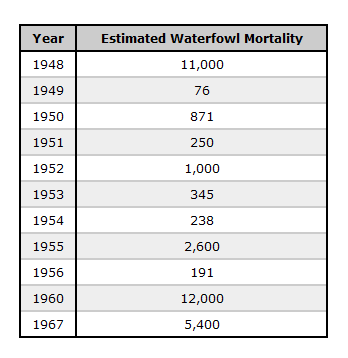

Status and Trends
A series of relevant legislative events followed the massive 1948 winter duck kill. In 1949, the Michigan Legislature amended the water pollution control statute to establish the Michigan Water Resources Commission (Cowles 1975). In addition, the definition of pollution was broadened and state approval was required for all new uses of state waters. Still, oil slicks were reported on the Detroit River one-third of the time during the winter and spring between 1950 and 1955 by the U.S. Department of Health, Education, and Welfare (1962).
Other sources of oil pollution in the Detroit River, in addition to industry, were soon recognized. Some of these include municipal wastewater treatment plants, government installations, combined sewer overflows, and shipping (International Joint Commission 1968). As these sources were identified, pollution control efforts became increasingly effective. According to the U.S. Department of Health, Education, and Welfare (1962), there was a 97.5% reduction in oil discharges to the Detroit River between the late 1940s and early 1960s (Figure 1). The Michigan Department of Natural Resources (1977) reported that there was an additional 80% decrease in point source discharges of oil between 1963 and 1976. As would be predicted, winter duck kills associated with oil pollution also decreased dramatically.
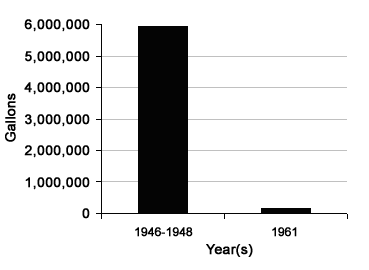
Figure 1. Total volume oil/other petroleum products spilled in Detroit River in gallons per year (1946-1948 and 1961).
Nevertheless, recent data collected by the U.S. Coast Guard National Response Center (2005) indicate that there are still years in which total volume of oil and other petroleum products spilled in the Detroit and Rouge Rivers is comparable to estimated oil releases in 1961 (Figure 2). In April 2002, a 100,000 gallon oil spill occurred in the Rouge River. The U.S. Coast Guard and other governmental and industrial partners undertook a $7.5 million cleanup on 27 miles of the lower Rouge River and U.S. Canadian sides of the Detroit River (Hartig and Stafford 2003). Ten ducks and geese died as a result of the oil pollution. While this number may seem insignificant to years past, it reminds us that oil pollution continues to be a threat to waterfowl.
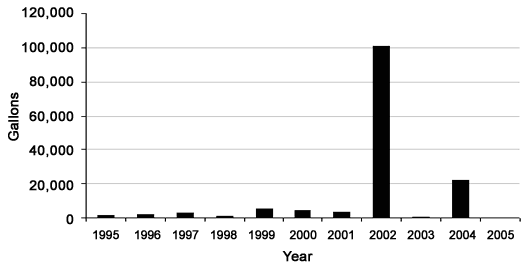
Figure 2. Total volume oil/other petroleum products spilled in Detroit and Rouge Rivers in gallons per year (1995-2005).
It is important to note that the data presented in Figure 2 merely reflect reported incidents. In addition, there are undoubtedly many unreported spills and releases through combined sewer overflow events that are not accounted for. These figures are therefore conservative. Figure 3 shows that 16-41 spills of unknown volume have occurred each year since 1995. Although these spills are probably small in volume, they are still a concern because of their frequency. Figure 4 demonstrates that more sheens were reported in some years than were total spills reported with volume, further documenting the ongoing release of oil of unknown volume into the Rouge and Detroit Rivers.
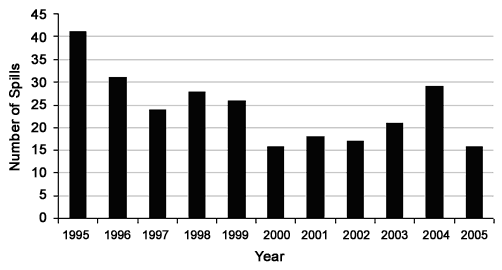
Figure 3. Number of oil spills with an unknown volume (1995-2005).
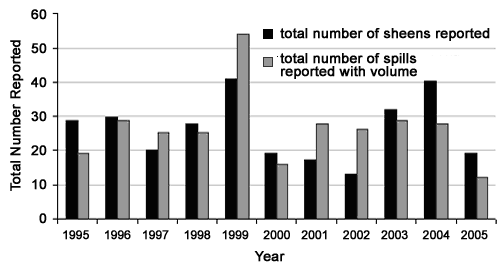
Figure 4. A comparison of total number oil spills reported with volume to total number sheens reported (1995-2005).
Oil pollution continues to be an important issue because of combined sewer overflow events and industrial releases. Figure 5 shows that since 1995, 17-40% of all the reported oil spills in Michigan occurred in the Detroit and Rouge Rivers.
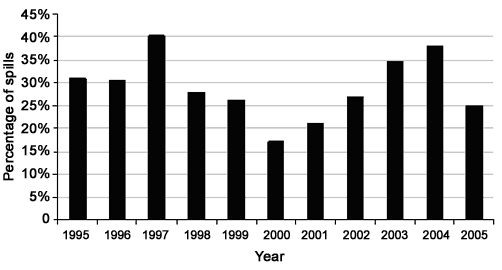
Figure 5. Percentage of Michigan oil spills that occurred in the Detroit and Rouge Rivers (1995-2005).
Management Next Steps
Even with state and federal enforcement programs, there are still frequent occurrences of small oil spills and even occasional large ones. Greater emphasis must be placed on prevention. Key management recommendations include:
- lower the allowable limits of oil and other contaminants from industrial contributors to Detroit and other municipal wastewater treatment plants;
- identify high priority outfalls that empty into the Rouge and Detroit Rivers and target them for implementing early warning systems;
- heighten Michigan Department of Environmental Quality and U.S. Environmental Protection Agency enforcement of industrial pretreatment programs;
- educate the business community that it shares the responsibility of preventing the problem and becoming a part of the solution to oil pollution;
- encourage industrial companies pursuing the voluntary ISO 14000 certification to identify oil as a "significant environmental aspect" in order to prevent accidental release of oil; and
- increase public awareness of the need to prevent pollution, notice changes in water quality, and report problems immediately.
Research/Monitoring Needs
An early warning system is key to protecting the Detroit and Rouge Rivers from oil pollution, and the wildlife that depends on these river ecosystems. It is recommended that governments pursue funding to expand implementation of early warning systems and monitoring devices for water systems.
References
- Cowles, G. 1975. Return of the River. Michigan Natural Resources Magazine. January-February Issue, Lansing, Michigan.
- U.S. Coast Guard National Response Center. 2005. Emergency Response Notification System (Data collected from 1982-2005). (December 2005).
- Hartig, J.H., and T. Stafford. 2003. The Public Outcry over Oil Pollution of the Detroit River. In, Honoring Our Detroit River, Caring for Our Home. pp. 69-78. Cranbrook Institute of Science, Bloomfield Hills, Michigan.
- Hartig, J.H. and M.E. Stifler. 1979. Water Quality and Pollution Control in Michigan. Michigan Department of Natural Resources. Publication Number 4833-9803, Lansing, Michigan.
- International Joint Commission. 1968. Pollution of the Detroit, St. Clair, and St. Mary Rivers, Washington, D.C. and Ottawa.
- Michigan Department of Natural Resources. 1977. The Detroit River: 1966-1976: A Progress Report. Publication Number 4833-9438. Lansing, Michigan.
- Michigan Department of Natural Resources. 2005. Oil Intoxication.(December 2005).
- Miller, H.J. and S.C. Whitlock. 1948. Detroit River ducks suffer heavy losses. Michigan Conservation. 17(4): 11, 15.
- U.S. Department of Health, Education, and Welfare. 1962. Pollution of the navigable water of the Detroit River, Lake Erie and Their Tributaries within the State of Michigan. Detroit, Michigan.
- U.S. Fish and Wildlife Service. 2005. Oil-soaked duck photograph. (December 2005).
Contact Information regarding Oil Pollution of the Detroit and Rouge Rivers
John H. Hartig, Refuge Manager
Detroit River International Wildlife RefugeU.S. Fish and Wildlife Service
E-mail: john_hartig@fws.gov
Rose Ellison, Environmental Scientist
Great Lakes National Program Office U.S. Environmental Protection Agency, Region VE-mail: ellison.rosanne@epa.gov
Commander Sean Moon
U.S. Coast Guard, Sector DetroitE-mail: smoon@msodetroit.uscg.mil
Olivia Napierski, Refuge Volunteer
Detroit River International Wildlife RefugeU.S. Fish and Wildlife Service
E-mail: liv570@hotmail.com
